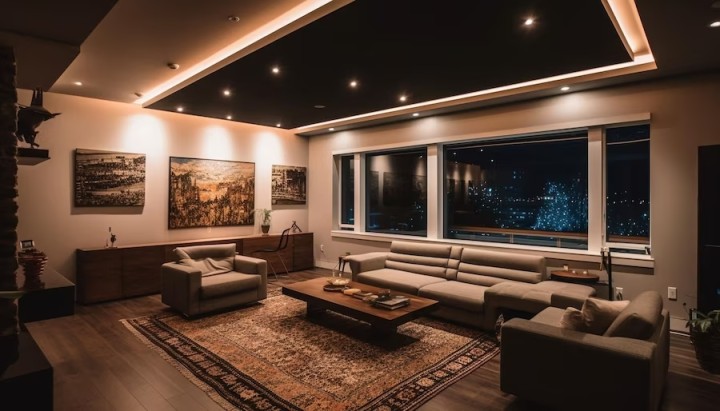
Whether you’re in a relaxing office, a vibrant living room, or a quiet bedroom, the kind and placement of lighting fixtures may have a big impact on how a space looks, feels, and performs. The magic is in the capacity to make subtle changes to lighting, such as adjusting brightness, color temperature, or source positioning, which when combined, can make a huge difference in both the emotional and functional aspects of a space. So, here are a few things you need to know about this topic and some of the most practical ideas you can turn into reality.
The Psychology of Lighting
It’s essential to explore the psychology of lighting before getting down to the finer points of lighting design. Light is a powerful weapon that influences our emotions, behaviors, and even our physiological reactions. It is not merely a necessary component. Bright, cold lighting that has color temperatures around 5000K can increase alertness, concentration, and productivity.
This makes it the perfect option for professional environments when concentration is essential. On the other hand, cozy, soft lighting that is often cooler in color (about 2700K) can promote emotions of comfort and coziness, making it ideal for relaxing in a living room or bedroom. Gaining a deeper awareness of the subtle emotional nuances of light will enable you to use it to create custom moods for various rooms in your house.
Adjusting Light Intensity
Changing the lighting intensity is one of the most basic yet profoundly effective ways to change the ambiance of a space. The ambiance can change from energetic and colorful to cozy and relaxed with the simple act of dimming the lights. Imagine a romantic atmosphere for a special dinner in a dining area that is bathed in soft, subdued light.
On the other hand, a well-lit workstation necessitates intense, concentrated illumination to promote productivity and focus. Consider adding dimmer switches or smart bulbs to your lighting system to get this level of control. With the help of these innovative solutions, you can easily adjust brightness levels to suit the work or mood at hand, giving your lighting design the maximum amount of versatility.
Layering Light Sources
The joy of lighting design typically rests in layering many types of light, even though regulating the brightness and color temperature of light sources is vital. This strategy combines ambient, task, and accent lighting, three basic lighting layers. The ambiance of the space is set by ambient lighting, which also provides general illumination. Task lighting is more specialized and concentrates light on particular spaces or activities, such as reading or cooking. Accent lighting enhances specific features, items, or architectural components, giving the space more depth and dimension.
These three levels can be strategically combined to produce a dynamic, flexible lighting plan that can accommodate various activities and moods throughout the day. However, making all those things true isn’t easy, which is why you might look for a professional instead of doing it all yourself. For instance, people behind the practical Your Electrical Expert might be able to help you turn your dreams into reality and take your lighting ideas to the next level, so start looking for help ASAP!
Playing with Color Temperature
Color temperature, a sometimes disregarded component of lighting design, may significantly alter how a space feels. The idea is based on how warm or cool light is, commonly measured in Kelvins (K). Higher color temperature cool white light—5000K or more—has a tendency to be energizing and supportive of alertness and concentration.
As a result, it’s a great option for rooms like home offices or kitchens where productivity is key. On the other hand, warm yellow or amber light, with color temperatures around 2700K, promotes emotions of coziness, comfort, and relaxation, making it suitable for spaces where unwinding and relaxation are the main goals, such as the living room or bedroom.
The Power of Lighting Control Systems
Technology advancements have completely changed how we operate and interact with our home’s lighting systems. Now enter smart lighting control systems, which provide lighting management with remarkable convenience and versatility. With these systems, you only need a few taps on your smartphone or a voice command to adjust the lighting in each area.
Imagine moving from a bright, stimulating morning light to a warm, inviting evening glow without ever getting up from your seat. Smart lighting systems also let you establish lighting scenarios for different activities or times of day, making sure the lighting is always consistent with the mood you want to create.
It is nothing short of amazing how even the smallest changes in lighting can have a significant impact on a room’s mood. Remember that lighting is your ally in creating the appropriate mood, whether you’re trying to create a comfortable, romantic evening or a productive day at work!
We hope you found this blog post on How Small Lighting Changes Can Greatly Impact the Mood of a Room, useful. Be sure to check out our post on Electricians Help with Outdoor & Landscape Lighting for more great tips!
Have Experience in the Moving Industry? Want an Additional Income Stream? Work With All Around Moving!
Partner with us and we’ll help you make money. If you want to apply your expertise in the moving industry, team up with us and we’ll help you make money. Click here to learn more.





